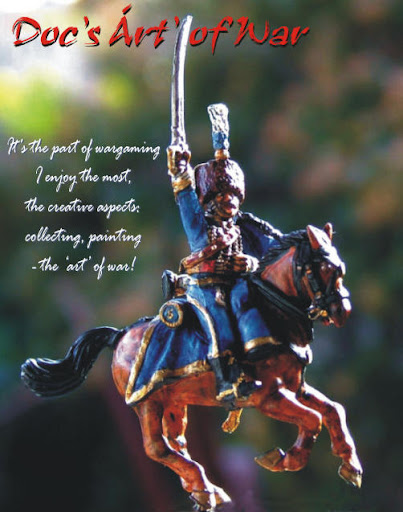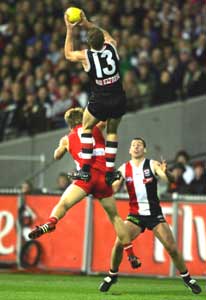The Prussian Guard on the march and under fire!
I know the BP boys are keen but while Doug and I can muster nearly two divisions of French between us, we have a shortage of Prussians - nobody seems to have any. As I have the lead, I have to get painting - and I would like to have a FPW game myself this year!
Jaeger skirmish screen advances through smoke and French shelling outside Mars La Tour
With this in mind, once I finished the Guard & Jaeger I decided to get all the FPW figures I had out to see where I needed to go next. Well, one thing lead to another AND as I had assembled my recently completed gaming table I decided to do a little reenactment - just 'cos I could! Not a game mind, but with all my painted FPW on the table I couldn't resist. Having finished the Prussian 12th Cavalry Bde I decided to try and depict the Mars-La-Tour 'Tottenritt' (Death-ride).
French guns on a ridge to the north of Mars-La-Tour
The story of Mars-La-Tour started with the French army in a good defensive position around Gravolette to the north. The Prussians were somewhat strung out in an attempted out flanking move further to the south. Neither side knew precisely the position of the other. The French furthest south were under Cranrobert just outside Mars-La-Tour village. A better part of a Prussian corps were passing to the south of the French position, strung out in line of march but well within range of French guns set up on a low ridge a bit over two miles to the north. Canrobert concentrated his artillery and plastered the Prussian infantry as they passed through and beyond the village.
Prussian command under fire at Mars-La-Tour face a dilemma -
silence the French guns or risk getting caught on the march
So much of a nuisance was the French fire that it threatened to disrupt the Prussian flanking movement. The ground between was undulating but open and the French guns were supported by infantry behind - any attempted attack by massed infantry would have resulted in even heavier casualties.
Jaeger skirmishers screening Mars-La-Tour come under increasing fire
The Prussians could only bring up a few guns which were no match for the massed French batteries and began to take heavy casualties. Prussian troops passing through the village also came under increasingly accurate fire which threatened to disrupt the Prussian march.
Prussian counter-battery fire is ineffective (even with Krupps guns!)
The Prussian Corps commander decided to use his available cavalry to buy him some time, ordering the 12th Brigade consisting of the famous Magdeberg Kuirassiers, Uhlan (lancers) and Dragoon regiments, about 1800 men in all, to silence the French guns. The Prussians must have known they were sacrificing their cavalry but were in desperate straights - if only Cranrobert had known how precarious the Prussian position was! Had he attacked with his infantry, he would have hit the Prussians in their flank and likely have inflicted a decisive defeat... but that never happened, instead it was the Prussians who attacked!
French command on ridge north of Mars-La-Tour (supporting infantry behind)
The Prussians reconnoitered and discovered a shallow fold in the undulating ground about 1,000 meters in front of the French position. They used this to carefully assemble their cavalry out of sight of the French.
The Prussian cavalry assemble in hollow ground before the French position
The French were startled when the Prussians literally popped out of the ground less than a kilometer in front of them. The Prussians approached at a brisk trot, shaking out into overlapping lines as they came on. It took them less than two minutes to cover the distance to the guns on the ridge, coming on so fast that the French could not depress their guns sufficiently to bring them to bear, most of the fire flying over the heads of the oncoming Prussians.
Most of the French artillery fire passed over the heads of the rapidly advancing Prussians
As the Prussian cavalry approached the French their guns, firing over open sights, started to tear holes in the Prussian lines but the momentum of the cavalry, who increased their pace to a full charge, carried them on into the French position.
The Prussians shake out into overlapping lines as the French guns begin to find their mark
- although most shells still sailed over the heads of the Prussians
So quick was the Prussian advance that it caught most of the French gun crews still serving their guns. The French supporting infantry, although only a few hundred yards behind, were also caught unawares by the Prussian advance and were rattled by sudden appearance of hordes of Prussian cavalry and the destruction of the French guns in front of them.
Prussians do great execution once among the French guns
Once through the gun line, the Prussians slammed into the startled French infantry who were unable to take advantage of the range of their Chassepot rifles (otherwise accurate up to 1800 meters in battlefield conditions!) The rattled French were driven back.
At this point the French Guard cavalry, who had ridden hard to intercept, should have taken the now disorganised Prussians in the flank, but further disaster struck. In all the dust and smoke, the French infantry mistook the white and light blue tunics of the French for Prussians and after repeated attacks by the latter, were shooting at anything on a horse. The French cavalry attack was disrupted by friendly fire, suffered considerable casualties and instead of driving home, were driven off by their Prussian counterparts.
French Lancers of the Guard were mistaken for Prussians at Mars La Tour
The end result of this Prussian "Death ride" was that although suffering over 50% casualties with covering fire from the Prussian artillery, they were able to withdraw virtually unmolested and had not only succeeded in silencing the French artillery but precipitated the panicked withdrawal of Cranrobert's French infantry.
The Prussians drive off the disorganised French counter-attack.
Rattled French infantry behind the ridge start to withdraw and the surviving
but exhausted Prussian cavalry are able to return to their lines unmolested.
Well, that was my painted FPW figures (so far) in action! Nearly enough for a game I think - its frustrating not being able to game with them at present - but a lot of painting still required. I've just finished another brigade command and and putting together a high command for the Prussians, similar to that done for the French (see earlier posts and the above photo of the French command at Mars-La-Tour).
Some of the above photos appear a little rough its because I had to use the low-light function on my Lumix. I've actually tried to replicate the look and feel of old French lithographs I've seen of FPW battles in some shots.
Some of the above photos appear a little rough its because I had to use the low-light function on my Lumix. I've actually tried to replicate the look and feel of old French lithographs I've seen of FPW battles in some shots.
My next post will likely be the Prussian High Command stand when I finish it.
Cheers,
Doc
























































